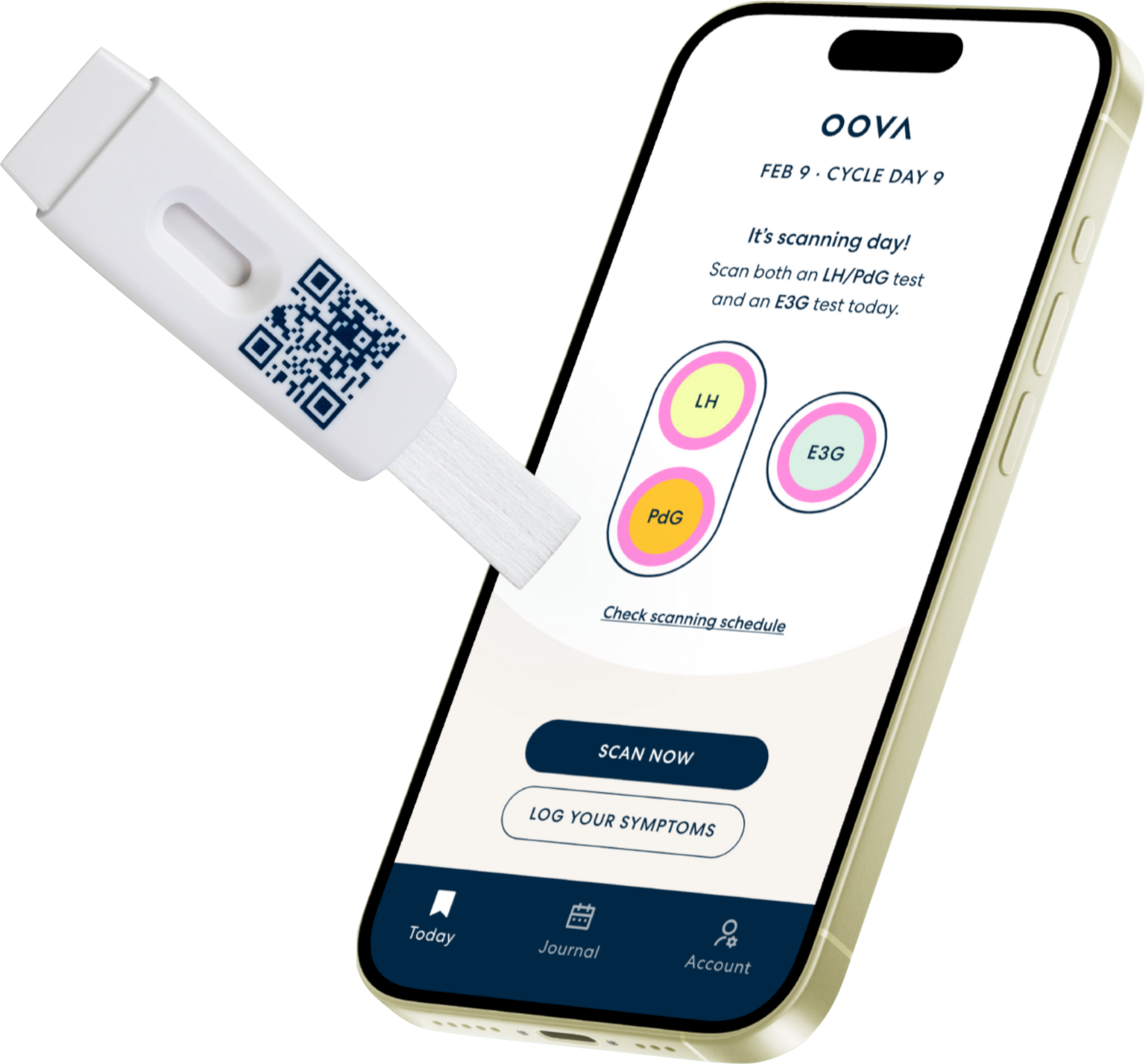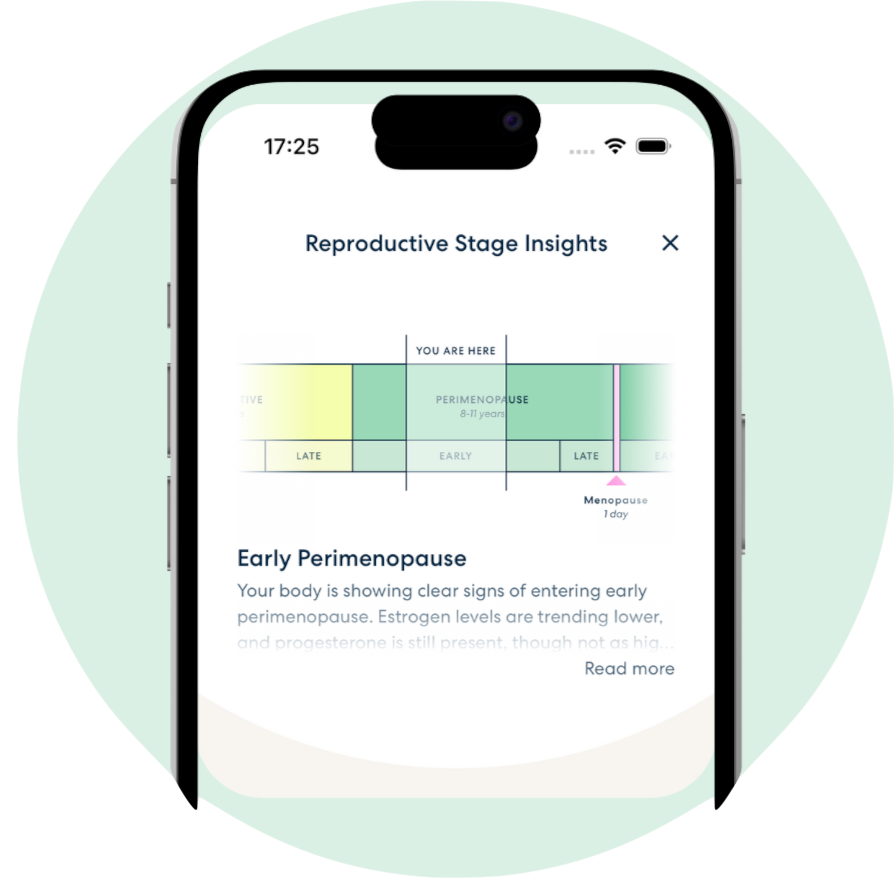Your Hormones. Your Answers. One App.
Take control of your health with personalized hormone insights. Oova's AI-powered platform transforms daily hormone scans into actionable guidance: pinpointing your fertile window, tracking ovulation patterns, identifying hormone imbalances, and learning your perimenopause stage.
Download The App

How can the Oova Kit help you?
- Perimenopause Map your transition with clinical precision, connecting symptoms to hormone changes and gaining clarity about your patterns and reproductive stage.
- Fertility Planning Pinpoint your ovulation timing, maximize conception chances, and identify underlying factors affecting fertility that traditional methods miss.
- Hormonal Health & Symptoms Understand how hormones influence migraines, mood, sleep, energy, and metabolism. Get targeted support for PCOS, hypothalamic dysfunction, and stress-related cycle issues.

Why is Oova Different
Oova is the only at-home test that measures three key hormones — E3G (estrogen), PdG (progesterone) and LH — using just your smartphone. No bulky devices or messy strips. Just scan, get precise data, and understand what it means for your body.
How does Oova work?
Oova helps you go from insight → action in just 10 mins
.png)
Capture the key hormones for mapping your cycle: luteinizing hormone (LH), E3G (an estrogen metabolite), and PdG(a progesterone metabolite).
.png)
Use your smartphone’s camera to scan your test strip. In minutes, your hormone levels are interpreted and presented with easy-to-understand explanations in the Oova app.
.png)
Receive insights in the Oova app each day. Seamlessly track your progress and share data with your doctor.
Your hormone patterns don’t need to be a mystery
Check out our most recent research
45-year-old conceives naturally after 3 cycles with Oova
Learn how
our technology works
46% of Oova users are over
Read
Oova
success
stories
87% of women don’t know when their fertile window is.
Learn about why Oova works for people with PCOS
Only 5% of Oova
users have a
"standard” 28-day cycle.
cycles scanned
with Oova
Our latest publication:
Early Progesterone Rise in the Follicular Phase: Predictor of Anovulation?
The Menopause Society 2024
Are estrogen levels associated with sleep quality?
Learn about how ovulation trends in PCOS
Only 5% of Oova users have a "normal” 28-day cycle.
Ready to Understand Your Hormones?
Join thousands of women who've taken control of their reproductive health with Oova.
Frequently Asked Questions
While we currently offer two guided Oova experiences for people trying to conceive and people navigating perimenopause, there are many other reasons someone may choose to use Oova. Oova can be used to track and predict ovulation if you are navigating a reproductive health condition like PCOS, trying to optimize your diet and exercise routines through cycle syncing, and determining if certain symptoms you are experiencing are hormone-based. Doctors also use Oova to remotely monitor ovulation patterns in their patients undergoing treatments.
Oova uses innovative biochemistry to accurately measure luteinizing hormone (LH), E3G (a metabolite of estrogen), and PdG (a metabolite of progesterone) in urine. All you need to do is pee on your test strip, and then scan the test with your phone’s camera. Learn more.
The Oova Membership is a more robust fertility solution. Members can access our peer community, 1:1 consultations with experts, and member-exclusive events. Members also receive 30% off their monthly test kits.
Oova monitors luteinizing hormone (LH), E3G (an estrogen metabolite), and PdG (a progesterone metabolite). Tracking LH and E3G helps identify your fertile window and monitoring PdG is essential for confirming ovulation. Learn more.
No - you can use Oova whether or not you are working with a doctor. If you’re not working with a doctor but are looking for expert support, the Oova Membership unlocks access to 1:1 consultations and guidance.
Unlike apps that rely on symptoms, basal body temperature, or predictions, Oova measures your actual hormone levels in real time. This means your insights are based on your body’s chemistry, not averages or guesses.
Absolutely. Oova generates HIPAA compliant provider-ready reports that can be exported directly from the app. These reports integrate seamlessly into medical conversations, helping you get faster, personalized care.
Yes. Your data is encrypted, HIPAA-compliant, and never sold. You control your information, and only you decide if or when to share it.
Each Oova strip is scanned using your phone’s camera. Our app’s AI interprets the results instantly, transforming them into clear hormone data and personalized insights.
Oova delivers lab-grade accuracy. Our tests measure LH, E3G, and PdG with 99% correlation to blood testing in independent lab-testing, giving you the same clinical quality results from home.
Many fertility medications affect hormone behavior throughout your cycle. By measuring LH, E3G, and PdG, Oova can help your doctor determine if these changes are happening as intended.
If your doctor is an Oova provider, they will receive your results in real-time. If not, you can still easily download a PDF of your results to share with them. Learn more.
After you pee on your LH and PdG test cartridge, you will start to see three lines develop. The top line is the control line (to see if the test is working), the middle line is PdG (a progesterone metabolite), and the bottom line is LH. The E3G cartridge has 2 lines. One for the control, and one for E3G (the urinary metabolite of estrogen). Learn more.
Sometimes, interpreting your results is confusing depending on your unique hormone levels. There are several specific hormone patterns that Oova users experience more frequently. Read the guide.
Oova can help discover the nuances of your hormonal changes. If you're unsure if you are entering perimenopause, our product helps you to monitor your hormone fluctuations so you can identify whether ovulation is still occurring. This data can help you track and predict ovulation to help you understand your cycle even if you are entering or already in perimenopause.
Note: according to NAMS, menopause is confirmed after 12 consecutive months without a period.
Yes! If you're trying to get pregnant amidst hormone changes and irregular cycles due to perimenopause, Oova provides invaluable insights based on your unique hormone profile. Unlike traditional ovulation tests, our hormone-tracking system identifies your unique fertile days and confirms ovulation, even if your cycle is irregular.
Navigating the world of hormone replacement therapy (including bioidentical hormone replacement therapy) can be overwhelming. Oova is a powerful tool to monitor your hormones and track your ovulation patterns, whether or not you are on HRT. Simultaneously, your provider can remotely see your data which your doctor may use to determine what other clinical assessments and testing may be needed. Oova is not a replacement for a doctor’s hormone testing.
For the Perimenopause Hormone Kit, you can choose to scan on your own schedule or follow Oova's guidance. We suggest scanning both an LH/PdG and an E3G test strip each day for 15 consecutive days. Depending on your goal, you may choose to begin testing once your period ends or at the onset of particular symptoms. Learn more here.
The Oova app will learn about your cycle and let you know when to scan. For five consecutive days you will scan just an E3G strip. Then for 10 days you will scan both LH/PdG test strip and an E3G test strip. Finally, for five days you will scan just your LH/PdG test strips. Learn more here.
Nope - anyone can download the Oova app for free. The app can be used manually as a symptom tracker even if you aren’t testing with Oova’s test strips. Try the app.
Oova measures LH, E3G (an estrogen metabolite), and PdG (a progesterone metabolite) quantitatively. We use an AI-powered app to detect fluctuations based on your unique hormone baseline, not an estimated “normal”. Learn more.
Oova is trusted by 100+ clinics. Oova is the only product of its kind that delivers quantitative hormone data to providers in real-time through a HIPAA-compliant clinician dashboard. Read our research.
Yes. Oova is ideal for women with irregular cycles because we track hormones quantitatively. This means you don’t just receive a vague “positive” or “negative” result. Oova’s results are based on your unique hormone profile. Learn more.
Many people with PCOS successfully use Oova. Unlike other fertility tests our AI-powered app delivers accurate results for every user by learning your unique fertility profile. Learn more.




